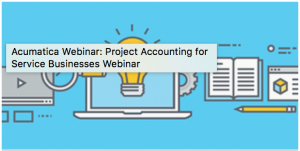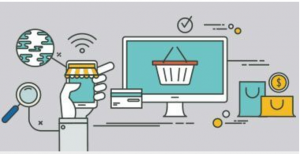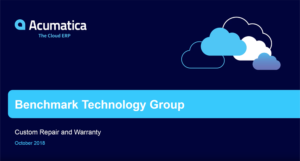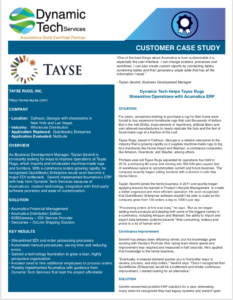The purpose of research is to inform action. It is important to examine information from a variety of sources before making an investment of time and money in your first (or a replacement) ERP system. You want to be sure you’re making the right choice the first time.
Use this page to discover and evaluate potential solutions for your business. Identify software that can improve efficiency and reduce costs. Learn more about the cloud and cloud software then determine the total cost of ownership (TCO) and return on investment (ROI) of your choices.
And finally, before you purchase, arrange a demo of the software you think will work best for your business.
But first, get “The Cost of Doing Nothing” white paper.

When adding ERP, companies typically follow a series of steps before their new system is up and running:
- Research – Identify needs and potential solutions
- Evaluation – Compare features and perform ROI analysis
- Selection – Choose the best fit
- Implementation – Go live
No matter where you are in this process, you can access a customized ERP knowledgebase here and ensure you have the right information so that you are best able to make the right decision.
When choosing a new ERP system, it’s important to take a look around and see what your options are.
With the Gartner Magic Quadrant for Cloud Core Financial Management Suites, you can get a non-biased, third-party view of the ERP competitive landscape and can educate yourself on the solutions available and how they compare and might fit your requirements.
You will get a description of each solution and see how they rank on Ability to Execute and Completeness of Vision.
In a crowded market there are many options. Pick the one that’s right for you.

Before moving forward with an ERP purchase, you need to know how much your system will really cost you and identify when you will break even on your investment.
Calculate the Total Cost of Ownership (TCO) of Your ERP Deployment
Calculate the Return on Investment (ROI) of Your ERP Investment
According to the National Institute of Standards (NIST), cloud computing is “a model for enabling ubiquitous, convenient, on-demand network access to a shared pool of configurable computing resources (e.g., networks, servers, storage, applications, and services) that can be rapidly provisioned and released with minimal management effort or service provider interaction.”
While accurate, that definition is broad and somewhat confusing.
Let’s keep it simple. Learn what the cloud means for you. Read the FAQs on the cloud and learn more about multi-cloud computing.
In 2009, 80% of mid-market ERP implementations were installed on premises. But, that has changed drastically in recent years. Now experts are predicting 50% of small and medium-sized business (SMB) ERP deployments will be in the cloud.
For many SMBs, the move to the cloud is done for obvious business reasons—the first one being lower up-front costs.
Learn about more trends and benefits and why the cloud is the future.
Cloud ERP is an approach to enterprise resource planning (ERP) that makes use of cloud computing platforms and services to provide a business with more flexible business process transformation.
Cloud-based ERP benefits businesses by providing application scalability and reduced hardware costs. In addition, cloud computing technology makes it easier to deliver ERP through a software as a service (SaaS) model for businesses who want to acquire ERP and not have to manage hardware, software, and upgrades —while reducing up-front expenses.
What is Multi-Cloud Computing?
Multi-cloud computing refers to a system implementation that relies on multiple cloud computing solutions at the same time, allowing for a “best-of-breed” solution as the best cloud services from leading cloud vendors can be implemented in response to your exact, targeted business requirements.
Get answers to your questions about cloud computing and ERP:
- What is ERP?
- What is cloud computing and what are the benefits?
- Is cloud computing safe?
- Do I have a choice where my data is stored?
- Can my current ERP data be migrated to the cloud?
- Plus more!
Read the Frequently Asked Questions about Cloud Computing and ERP.
What are the pro’s and con’s of the different mid-market ERP solutions? How do they compare? Which is better suited for your business requirements?
Maybe you’re outgrowing your current system. Maybe you’re on a legacy system that’s slowly being sunset-ed by its publisher. Maybe you need new functionality because your business has changed.
Every ERP has its own unique strengths and weaknesses.
Choose the one that fits (or improves) your current processes and is flexible and powerful enough to meet your needs as your business grows.
MORE WEBINARS
Find your complete lists of upcoming live webinars as well as recorded webinars.
MORE WHITE PAPERS
Find a complete list of white paper here.
Learn how our customers benefit from their ERP system first hand. Each case study represents a customer success and highlights the benefit of Enterprise Resource Planning solutions.
Benchmark Technology Group Uses Acumatica Customization Tools to Solve a Unique Workflow
Benchmark was able to use the Acumatica framework to build a custom workflow for tracking warranties and repairs.
Tayse Rugs Streamlines EDI, Operations with Acumatica ERP
With e-commerce orders growing rapidly, Tase Rugs recognized QuickBooks Enterprise would soon become a major bottleneck, so they implemented Acumatica’s ERP because of its modern technology, integration with third- party software and ease of customization.
Over the years, Acumatica has been recognized by many organizations and publications for the strength of their product and for the outstanding work they do.
These awards serve as acknowledgement of Acumatica’s dedication to excellence in both the products and services they provide as well as confirmation that Acumatica is truly exceptional and a rising star in the software industry.
Now that your ERP research is progressing, maybe it’s time to consider Acumatica.
Overview
Acumatica is a high-value, flexible ERP solution. Some customers have realized 400% productivity gains. Others cut processing time by 35%. One saw a savings of $80,000 per year after switching from QuickBooks.
Learn more. Get the Acumatica Product Overview, explore how other companies have benefited from Acumatica, review what our customers say about the solution and our services, or attend an event.
Pricing
Acumatica pricing is based on four factors:
- What applications do you want to use now
- Where do you want to deploy the software (on premises or in the cloud)
- Will you purchase the license or an annual subscription
- How much computing power and data storage do you need
Contact us to get your price for Acumatica.
Awards
Acumatica is frequently recognized for the excellence of its products and services.
Find Acumatica’s latest recognition here.
Product Tour
View the Acumatica Product Tour, or request a demo of the software before you make your purchase.




















